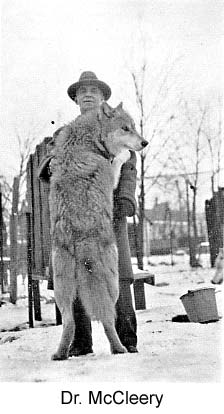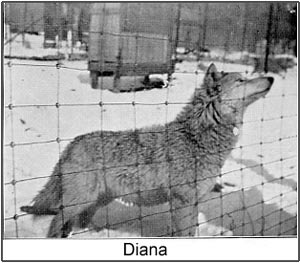The Lobo Wolves

Almost anyone who has lived in this area since the 1930s remembers the Lobo wolves of Kane. Brought to this area in the early 1920s by Dr. Edward H. McCleery, a Kane physician, the wolves were exhibited at a wolf farm on the outskirts of Kane for over 40 years. McCleery, who managed his wolves with devotion and affection, owned and operated the wolf farm until just before his death on May 23, 1962 at the age of 94.
The Lobo Wolves '"Canis Lupus Nubilus" derived their name from a word in the Blackfoot Indian language meaning "Buffalo Wolf", which, when spoken aloud, sounded like the word "lobo". They were also known as the Buffalo gray, or Loafer wolf, and followed the migration of the buffalo herds throughout the Rocky Mountains, from northern Canada to New Mexico. A large lobo wolf could weigh as much as 100 pounds and had a life span of about 20 years. They were described as the consummation of absolute savagery, and had seldom been tamed.
Such wolves were considered dangerous and predatory to the large cattle population in the western states in the early part of the 20th century. Consequently, the United States Biological Survey and the Canadian government began an extermination program of these wild wolves, which was declared a success in 1920. The Lobo wolves were literally on the edge of extinction.
But then Edward McCleery stepped in. McCleery led an interesting life. He was born in 1867 near Milton, PA, and educated as a physician at the University of Pennsylvania and Jefferson Medical College in Philadelphia. Following graduation, he went west, and practiced medicine at Cheyenne, Wyoming for two years before coming to Kane in 1894. While out west, he became a great admirer of wolves, and a champion of their survival. McCleery began to dream of owning his own pack to assure the survival of the lobo wolf.

He obtained his first wolf from Wyoming in January 1921, and named him Jerry, and over time, admitted that Jerry was his favorite. In May, 1921, he obtained two more pair of white wolves, naming them Lobe, Boreas, Montana and Diana. Later, he obtained more wolves, bred those that he had, and eventually ended up with 40 pairs of wolves.
He often took them for walks in the woods around Kane, on the end of a long chain, and for rides in his automobile. In the mid 1930s, McCleery wrote a small book entitled "The Lone Killer", which described his training techniques, feeding programs, and a history of his Lobo wolf pack. He retired from active medical practice in the early 1930s and devoted the remainder of his life to the care of his wolves. His work with wolves received worldwide recognition.
But in January 1962, with his health failing, and nearly 41 years after he adopted his first wolf, McCleery sadly realized that the wolf pack would have to be sold. Mr. and Mrs. Jack Lynch, formerly of Milwaukee, WI purchased the farm from Dr McCleery. The McKean County Democrat of Feb. 8, 1962 carried an article relating to that sale. The Lynches operated the farm until at least 1970.
McCleery's life-long work and ambition will long be remembered in this area. His devotion to a nearly extinct species '"the Lobo wolf" and his successful efforts to bring it back are truly commendable.
View a video of the wolves at the Dr. E. H. McCleery Buffalo Wolf Foundation
History of the pack through newspaper articles
- Updated October 18, 2012


